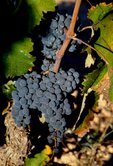|
 |
| Monastrell grapes |
Jumilla-the land of Monastrell: Jumilla,
a region whose rich, hefty wines are made from the indigenous
Monastrell grape, have historically been used for blending,
has now come into its own. No longer the rustic country
bumpkin, Jumilla now produces wines that are finding
a growing audience of fans of ripe, fruity, full-flavored
wines that are reasonably priced and compare favorably
to those from warm-country growing areas such as California
and Australia.
Beautiful location: Located in an
arid mountain valley, some 80 kms. inland from the Mediterranean
Coast of Alicante, southwest of Valencia in the province
of Murcia, Jumilla's 100,000-plus acres of vineyards
are planted at altitudes that range from 400 m- 900m
above sea level. Temperatures here can be extreme, soaring
to more than 100 degrees on summer days and dropping
to well below freezing in winter. Jumilla gets some
3,000 hours of sun per year and only about 16 inches
of annual rainfall, but roots of traditional old vines
burrow deep in search of moisture and most modern vineyards
are fed by drip irrigation.
Altitiude is the key: Don't be fooled
by the climatic conditions in Jumilla. Like many other
regions in Spain (the second most mountainous country
in Europe), the secret behind making successful, balanced
wines in areas that would seem to be too warm to make
seriously good wines, is altitude. The vineyards' thermostats
may be cranked up during the daylight hours in summer,
but at night temperatures at these altitudes cool down
dramatically. This allows the vines a good night's rest
to buttress themselves for the coming day and is the
secret behind Jumilla's emergence from near obscurity.
The grapes get properly ripe, but still have enough
acids because of the cool nights to carry the hefty
weight of the wines they produce.
The brownish soil (with underlying chalk) and the arid
conditions in Jumilla are inhospitable to the Phylloxera
bug that devastated Europe in the late-19th century;
so inhospitable that many old Monastrell vineyards in
Jumilla are planted on pie franco, or ungrafted
French rootstock.
In contrast, the vast majority of vineyards in Europe
had to be grafted long ago onto American, phylloxera-resistant
rootstock.
Page
1 2 3
4 |